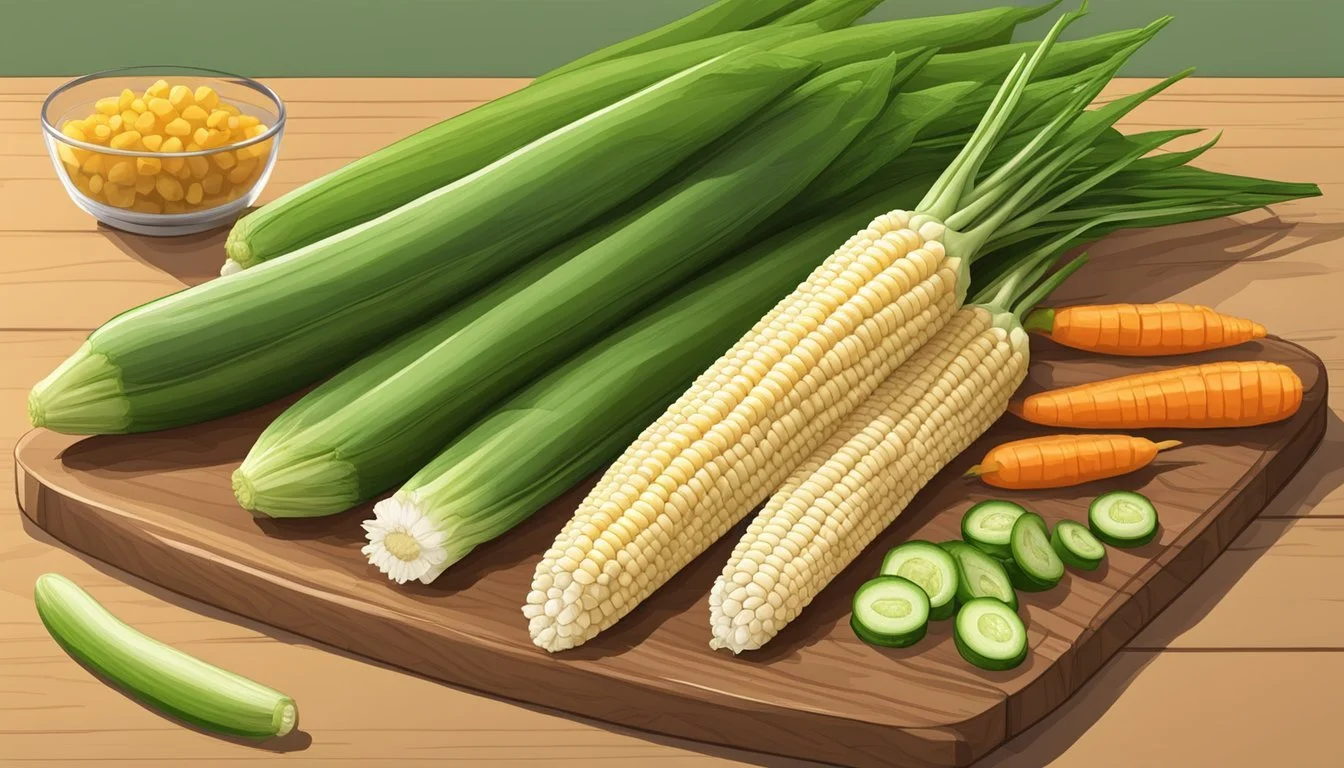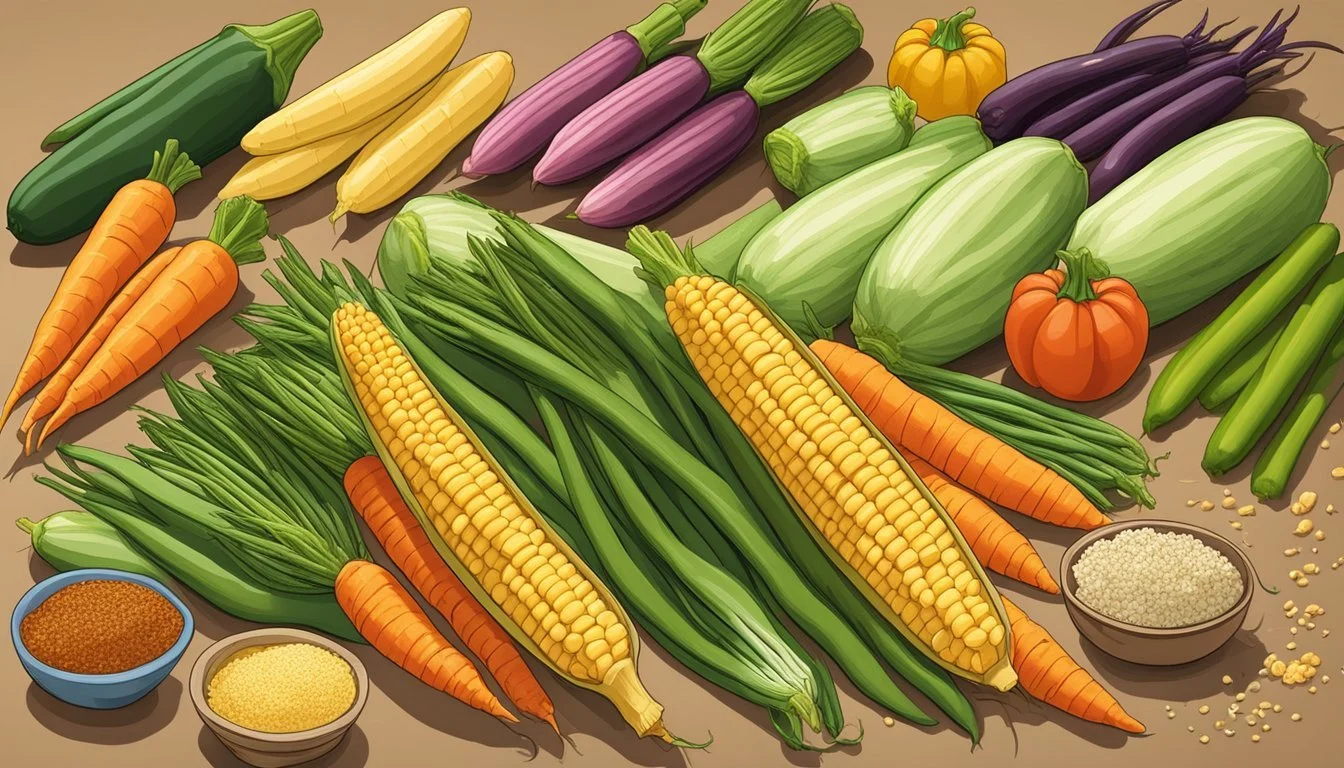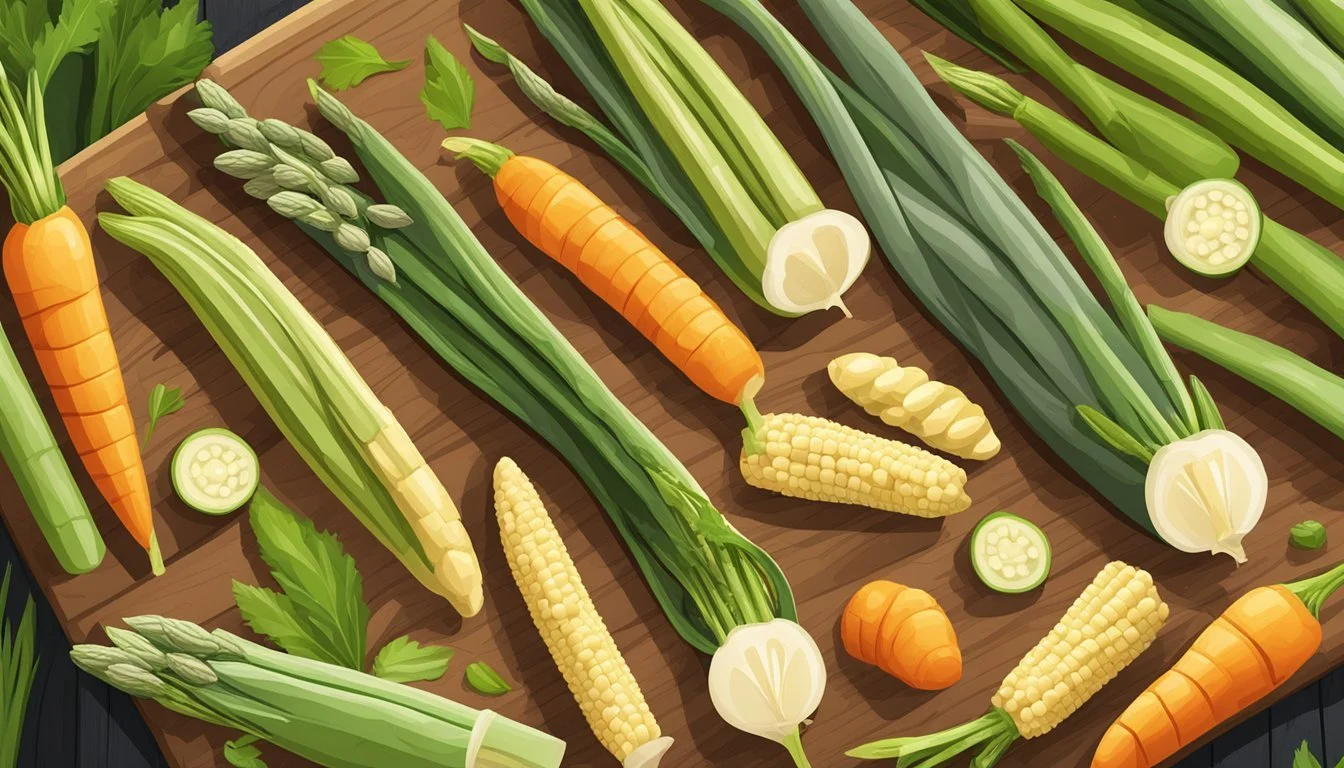Baby Corn Substitutes
Top Alternatives for Recipes
Cooking with baby corn can bring a unique crunch and sweetness to various recipes. But what happens when the shelves are empty or you want to try something new? Substituting baby corn is easier than you think and can be done with several common ingredients. These alternatives can seamlessly blend into salads, stir-fries, or even casseroles, keeping the texture and taste profile close to the original.
Quinoa offers a similar texture and is fantastic at absorbing flavors, making it a great addition to stir-fried dishes. For a slightly different twist, consider using broccoli or cauliflower, which can easily be chopped to mimic the size of baby corn. Both will retain a firm texture when cooked, adding a delightful crunch to recipes that demand baby corn's charm.
When looking for canned or jarred substitutes, regular corn kernels can also serve as a straightforward replacement. They may not have the same aesthetic appeal, but they bring a comparable sweetness and texture to dishes. Small, tender vegetables like zucchini are other viable options, ensuring you won't miss out on the delightful experience baby corn offers.
Understanding Baby Corn
Baby corn, also known as Chinese baby corn, is a miniature version of regular corn harvested early while the ears are still small and immature. It is a unique ingredient that offers distinct culinary uses and health benefits.
Common Baby Corn Substitutes
Finding the perfect substitute for baby corn can be simple with a variety of vegetables, grains, legumes, and starch-based thickeners available. Each option brings unique flavors and textures to your dishes.
Vegetable Alternatives
Several vegetables can mimic the texture and taste of baby corn. Broccoli and cauliflower florets work well in stir-fries and salads. They offer a similar crunch and absorb sauces effectively.
Zucchini is another versatile substitute. Sliced into thin rounds or strips, it provides a mild flavor and firm texture suitable for many dishes. Carrots, especially when diced or julienned, can also be a great alternative. They add a slight sweetness and crunch.
Grain and Legume Alternatives
Grains and legumes can also replace baby corn in many recipes. Quinoa is a popular choice due to its similar texture and ability to absorb flavors. It works well in salads, soups, and casseroles.
Rice offers versatility. Its neutral taste and variety of types, such as white, brown, or wild rice, allow it to complement many dishes. Beans like chickpeas or kidney beans can add heartiness and protein, making them excellent for soups and stews.
Starch-based Thickener Alternatives
When thickening dishes, several starches can be used in place of corn-based thickeners. Tapioca starch is a good substitute. It’s effective in both hot and cold recipes and adds a glossy finish.
Potato starch is another viable option. It provides a transparent, smooth consistency ideal for sauces and soups. Arrowroot powder offers similar benefits, particularly useful for acid-based recipes since it doesn’t break down. Cornstarch, if permissible, can always replace baby corn directly in many applications.
Incorporating Substitutes in Cooking
Swapping out baby corn in recipes can easily be done while maintaining flavor and texture integrity. By adjusting the ingredients and techniques, one can seamlessly integrate alternatives into various dishes.
Altering Recipes for Baby Corn Substitutes
When replacing baby corn, it's essential to choose substitutes that replicate its crunchiness and mild flavor. Quinoa and rice are excellent for stir-fries and casseroles, offering a similar texture.
For salads and soups, chickpeas can serve as a nutritious alternative, adding protein and fiber. Potato starch works well as a thickener in sauces and soups, allowing for a smooth consistency without compromising taste. These replacements ensure the dish remains balanced and enjoyable.
Cooking Techniques for Substitutes
Adapting cooking techniques is crucial when using substitutes for baby corn. Quinoa should be rinsed and cooked until fluffy, then added directly to the dish. For rice, cook until tender before incorporating into casseroles or stir-fries.
Chickpeas should be cooked until soft; they can be roasted for extra texture or simmered in soups. For thickening sauces, potato starch can be dissolved in a small amount of cold water before being added to the hot liquid. This prevents clumping and ensures a smooth, thickened sauce.
Special Diet Considerations
When considering substitutes for baby corn, it’s crucial to address various dietary needs such as gluten-free and vegan preferences, as well as low-sugar and low-fat requirements.
Gluten-Free and Vegan Options
For those adhering to a gluten-free diet, rice, quinoa, and cauliflower rice are excellent substitutes. They not only provide a similar texture but also offer additional nutrients. Quinoa, for example, is a complete protein source, while cauliflower rice is low in calories and carbohydrates.
Vegan options include zucchini and carrots. Zucchini can be spiralized to mimic the shape and texture of baby corn. Carrots, when sliced thinly and steamed, provide a crunchy and sweet alternative.
Low-Sugar and Low-Fat Substitutes
If you need a low-sugar alternative, cucumber slices and celery sticks are ideal. Both are low in natural sugars and calories, making them suitable for those monitoring their carbohydrate intake. Cucumbers are hydrating and rich in vitamins, while celery offers a satisfying crunch with minimal calories.
For low-fat substitutes, consider snap peas and green beans. These vegetables are not only low in fat but also high in fiber and essential nutrients. They are easy to incorporate into various dishes, from salads to stir-fries.
By selecting these alternatives, one can maintain dietary compliance while enjoying flavorful and nutritious options.
Selected Substitute Profiles
When baby corn isn't available, various substitutes can take its place in recipes. Each substitute has unique characteristics, from vegetables with similar textures to grains and legumes that adapt well to various dishes, and even nuts and seeds that can offer a unique twist.
Vegetable Substitutes Profile
Cauliflower is a versatile vegetable that can replace baby corn in many dishes. It has a mild taste and firm texture that holds up well in stir-fries and salads. Simply chop it into small, bite-sized pieces.
Broccoli offers a slightly stronger flavor but can be a good substitute due to its crunchiness. Broccoli florets can be used in place of baby corn in salads, soups, and stir-fries, providing both texture and nutrition.
Zucchini is another excellent option. With its mild flavor and tender texture, zucchini can be sliced into thin sticks or rounds, making it a suitable stand-in for baby corn in sautéed or grilled dishes.
Grains and Legumes Profile
Quinoa is a grain known for its nutritious profile and ability to absorb flavors. It can act as a textural substitute in dishes where baby corn provides bulk, such as salads or casseroles. Quinoa’s fluffy texture complements a variety of ingredients.
Barley has a chewy texture similar to that of corn kernels. It works well in soups, stews, and casseroles, providing a hearty and filling alternative.
Amaranth is a small, grain-like seed that offers a slightly crunchy texture. It can be used as a base or mixed into dishes where baby corn might be used, adding a unique texture and nutritional benefits.
Nut and Seed Substitutes Profile
Nuts such as chopped almonds or cashews can be used in place of baby corn to add a crunchy texture to stir-fries and salads. They bring a different flavor profile but can enhance the dish with their richness.
Pumpkin seeds and sunflower seeds are other options that can replace baby corn in terms of texture. They can be sprinkled over salads or mixed into vegetable dishes, offering a satisfying crunch without overwhelming the other flavors.
By considering these profiles, cooks can effectively substitute baby corn in their favorite recipes, ensuring both the texture and flavor are balanced to perfection.
Alternatives to Corn-Derived Products
This section addresses substitutes for corn-based ingredients, focusing on alternatives for corn syrup in sweetening and corn oil in cooking.
Sweetener Substitutes for Corn Syrup
Corn syrup can be replaced effectively with various options depending on the desired outcome. Honey is a natural sweetener that can replace corn syrup in a 1:1 ratio. It adds a distinct flavor and some antioxidants, making it ideal for baked goods and dressings.
Agave syrup, derived from the agave plant, is another fitting substitute. It offers a mild flavor profile and is equally sweet. Use it in a 1:1 substitution for corn syrup. Maple syrup can also be used, offering a robust flavor that complements pancakes, waffles, and desserts.
Simple syrup is easy to make by dissolving one part sugar in one part water. This mixture mirrors corn syrup’s sweetness and is suitable for cocktails and certain desserts.
Oil and Fat Replacements for Corn Oil
When replacing corn oil, several alternatives stand out. Olive oil is a healthy substitute with a rich, fruity flavor, excellent for salad dressings and sautéing. It contains beneficial monounsaturated fats and antioxidants.
Canola oil is another versatile option. It is neutral in flavor and suitable for baking, frying, and general cooking. It provides a balance of omega-3 and omega-6 fatty acids.
For high-heat cooking, grapeseed oil and vegetable oil are appropriate choices. Grapeseed oil has a high smoke point and is rich in polyunsaturated fats. Vegetable oil, typically a blend of various plant oils, is a cost-effective and accessible alternative.
Coconut oil adds a unique flavor and works well in baking and sautéing. It is solid at room temperature, which can be advantageous in certain recipes.
Substitute Pairings and Combinations
Pairing baby corn substitutes effectively in your dishes involves understanding both the flavor profiles and textures to create a balanced and tasty meal. Specific ingredients like garlic, onion, lemon, and mushrooms can enhance the substitute's characteristics.
Flavor Pairings for Substitutes
Quinoa and rice, as substitutes for baby corn, benefit greatly from bold flavor enhancers. Garlic adds a robust depth to quinoa dishes, while caramelized onions impart a sweet, savory taste to rice recipes.
Incorporating a squeeze of lemon can elevate the freshness of both quinoa and rice. Mushrooms, sautéed with garlic and a touch of vinegar, complement the earthiness of quinoa, making it a delightful side dish or main course.
Adding these elements ensures that the substitute not only fits texturally but also integrates well flavor-wise.
Textural Combinations in Dishes
Baby corn is known for its crisp texture, which can be emulated by other ingredients like bell peppers and sliced bamboo shoots. These alternatives provide a similar crunch to dishes like stir-fries and salads.
In soups or stews, consider using potatoes or carrots, as they maintain a firm texture even when cooked. For side dishes, avocado can be used for its creamy texture, pairing well with the crunchier substitutes.
Combining these elements thoughtfully ensures a harmonious balance in the overall dish, satisfying both texture and taste expectations.
Shopping and Storage Tips
Choosing the best substitutes for baby corn requires careful attention to quality and freshness. Proper storage methods can ensure that these substitutes maintain their flavor and texture.
Selecting Quality Substitutes
When selecting substitutes for baby corn, freshness is key. Look for vegetables like carrots, zucchini, or snap peas, which can mimic the texture and size of baby corn. Choose products that are vibrant in color and free of blemishes or soft spots.
For canned or jarred substitutes, such as mini corn-on-the-cob, check expiration dates and ensure the containers are sealed and free from dents. Frozen alternatives are also a good option; make sure the package is not damaged and there is no evidence of thawing and refreezing.
High-quality substitutes will help maintain the desired texture and flavor in your recipes, whether you’re using them in stir-fries, salads, or soups.
Storing Substitutes for Freshness
Proper storage methods can extend the freshness of your baby corn substitutes. Fresh vegetables should be stored in the crisper drawer of your refrigerator. Place them in perforated plastic bags to allow for air circulation, which helps prevent mold.
Canned substitutes should be kept in a cool, dry pantry. Once opened, transfer them to an airtight container and refrigerate. Use these stored items within a few days for optimal taste.
Frozen substitutes should remain in their original packaging until use. Store them in the coldest part of the freezer to avoid temperature fluctuations. Proper storage methods ensure your substitutes retain their quality and flavor, enhancing your dishes.
Enhancing Your Cooking Repertoire
In cooking, expanding your ingredient palette can breathe new life into familiar recipes. When substituting baby corn, knowing alternatives and how to apply them makes a world of difference in various dishes.
For salads, try using quinoa. It mimics the texture of baby corn and absorbs dressings well. Red bell peppers also add a sweet crunch, especially when fresh.
In gravies and soups, potatoes and carrots serve as excellent substitutes. They thicken the base and provide a hearty nature. Potato starch can replace cornstarch in thickening without altering the flavor.
Baked goods often call for corn syrup. Simple syrup made from sugar and water can be a direct replacement. Prepare by boiling ¼ cup of water and dissolving 1 cup of white sugar.
Popcorn can be substituted with roasted chickpeas for a crunchy, nutritious snack.
When making tortillas, consider using rice flour or quinoa flour. Both provide unique textures and flavors, perfect for diverse meal preparations.
Grains such as rice and quinoa offer versatility in casseroles and stir-fries, ensuring that your culinary creativity is never hindered by a single missing ingredient.
By integrating these substitutes, your cooking repertoire not only remains intact but also expands, opening new avenues for delightful culinary creations.









